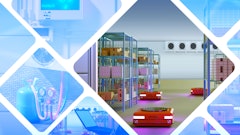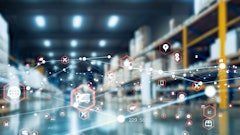
2022 saw a lot of instability within the supply chain. From port strikes and rail strikes to inflation, driver shortage and more, industry experts predict it may take supply chains close to 2-3 years to turn around.
Fast forward to present day, and more than half of executives do not expect a return to a “normal” supply chain until the first half of 2024 or beyond.
In Food Logistics’ January/February 2023 issue, editor-in-chief Marina Mayer talks with several industry experts about the top supply chain threats to impact supply chains in 2023.
Here’s an interview with Glenn Koepke, GM of network collaboration at FourKites, who details the importance of micro-fulfillment centers and supply chain tools in achieving a more stable supply chain. [CLICK HERE to read the article in full].
Food Logistics: 2022 saw a lot of instability within the supply chain. Port strikes, rail strikes, driver shortage and more. Industry experts even predict it may take supply chains close to 2-3 years to turn around. From your vantage point, how do these factors impact/influence the way companies can mitigate supply chain threats?
Glenn Koepke: While the labor component of supply chains and global shipping routes will likely remain a concern for shippers and beneficial cargo owners (BCOs), many companies have become immune to these scenarios due to the constant concerns and threats of the past few years. Shippers and BCOs have offset these concerns by building up additional inventory when possible, extending planned transit times and improving communication and collaboration.
The silver lining of inflation and the economic headwinds it has created is that capacity will become more widely available, on-time performance will improve and transportation costs will decline. With a slight lull, supply chain professionals will have an opportunity to invest in training, more digitization and other efforts to improve operations. I suspect that the supply chain landscape of mid-to-late next year will be our new normal for a while.
However, disruption is always inevitable — shippers and carriers can mitigate it by continuing to invest in things like end-to-end real-time visibility, network collaboration and efforts to attract, retain and train talent. Since the inception of COVID, the idea of a stable supply chain is completely foreign, and the next 2-3 years will not be a turnaround scenario but will be focused on creating as much stability as possible despite the global instability.
Food Logistics: What are some of the cold food chains biggest threats to date? And why? (some examples are food safety, cargo theft, driver shortage, war overseas, looming strikes from rail/dock workers, natural disasters and more)
Koepke: Warehousing capacity remains very volatile, especially in the cold storage market. Cold chains require a significant investment in assets or partnerships to ensure available warehousing capacity in key geographic markets to meet customer demands.
In addition, the handoff between providers, inevitable delays and unpredictable extreme weather events make cold chain shipping a challenge. Evidence of these difficulties is that roughly one-third of global fresh fruits and vegetables are thrown away because their quality has dropped below an acceptable limit. While major disruptions always pose a threat, it is the lack of monitoring, alerts, collaboration and communication that most often dooms cold food chain shipments.
Food Logistics: How can supply chain management and other solutions help companies overcome such threats?
Koepke: Supply chain tools allow companies to better understand their network, especially supply-and-demand and the transport market. Cold chains require a network of facilities from harvest to plates that include facilities, packaging, transport, quality controls and network monitoring. Technology, process and applied expertise facilitates the delivery of the perfect order throughout the network and make managing disruptions easier when they occur.
Communication and collaboration, enabled by data and digitization, is the best way to overcome these cold chain challenges. To start, shippers must monitor temperature end-to-end, whether the load is in-transit or at rest. Monitoring can then be augmented by automated alerts, letting staff know when a shipment falls outside the required temperature threshold or if it is delayed. Even better, look for a solution that offers real-time, dynamic estimated times of arrival for the entire journey.
With the right data and tools in place, shippers can then focus on optimizing their network design and working with suppliers and partners to have contingency plans for critical chokepoints in the cold chain.
Food Logistics: How has the influx of e-commerce put supply chains in danger of incurring more/different kinds of threats?
Koepke: With e-commerce companies having a limited barrier to entry, the largest focus has to be on food safety and FDA compliance. The primary threat to large, established companies – especially those that have invested in a very secure supply chain – is around competitive differentiation, as e-commerce startups can take on more risk and attempt to capture market share.
From a supply chain network view, e-commerce has led to the rise of micro-fulfillment centers (MFCs). While MFCs have made retail supply chains more efficient, they can put more pressure on inventory availability and create a need for accelerated transit times, more carriers and a broader set of lanes to manage.
Micro-fulfillment also upends traditional network design models that shippers and retailers are accustomed to running. In the past, most retailers re-examined their networks every few years. However, in the age of micro-fulfillment, they should do so at least annually — if not even more frequently — as new MFCs come online. This puts added pressure on food and beverage suppliers.
However, MFCs also allow for products that have been sitting at certain nodes in the supply chain to be sold and distributed more quickly, eliminating the need for discounts as these products become out of date or out of season. This can mean higher volumes and more profit for food companies when managed correctly.
Food Logistics: What are some things not addressed above that may be pertinent to our readers?
Koepke: FourKites and Food Shippers of America (FSA) surveyed more than 115 industry leaders to identify the most pressing logistics challenges in the food and beverage community, as well as the impact of ongoing economic, geopolitical and supply chain disruptions.
Results reveal that the three biggest challenges facing the food shipping industry are:
● Labor and talent management (49%)
● Transportation capacity issues (39%)
● Supply and demand planning disruptions (35%)
According to the results of the survey, difficulty with supply and demand planning, product availability and warehousing were more likely to plague enterprise companies with sales of $500 million or more. While these were also top concerns for smaller food and beverage shippers with less than $500 million in sales, those companies were more likely than their larger peers to cite store operations and transportation rates as the primary challenges.
Underlying these issues, shippers indicated that COVID-19’s impact on labor (56%), over-the-road capacity constraints (44%), port delays and congestion (30%), and changes in consumer behavior or buying patterns (22%) have all disrupted operations and created or exacerbated today’s challenges. In fact, since the pandemic began, more than 30% of respondents have seen a drop in customer loyalty, while 55% have seen a sales decline or miss due to product shortages. The financial impact was more acute among enterprise companies, with more than 65% indicating losses.
Looking ahead, a significant majority of companies (75%) say they are “concerned” or “very concerned” that rising inflation and geopolitical uncertainty will negatively impact sales during the fourth quarter of 2022.
[CLICK HERE to read the article in full].





















